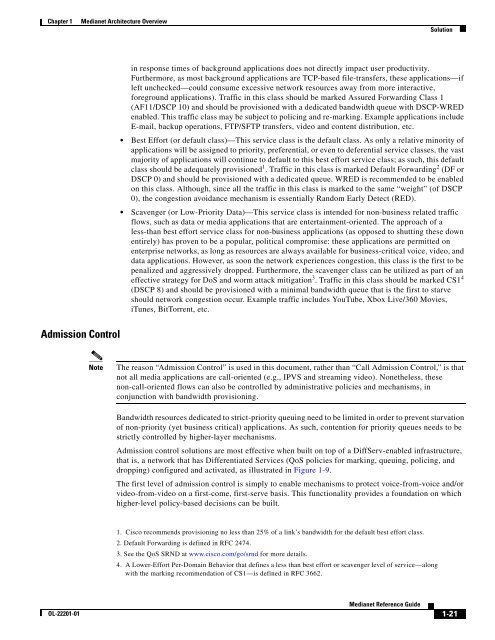Medianet Reference Guide - Cisco
Medianet Reference Guide - Cisco
Medianet Reference Guide - Cisco
Create successful ePaper yourself
Turn your PDF publications into a flip-book with our unique Google optimized e-Paper software.
Chapter 1<br />
<strong>Medianet</strong> Architecture Overview<br />
Solution<br />
Admission Control<br />
in response times of background applications does not directly impact user productivity.<br />
Furthermore, as most background applications are TCP-based file-transfers, these applications—if<br />
left unchecked—could consume excessive network resources away from more interactive,<br />
foreground applications). Traffic in this class should be marked Assured Forwarding Class 1<br />
(AF11/DSCP 10) and should be provisioned with a dedicated bandwidth queue with DSCP-WRED<br />
enabled. This traffic class may be subject to policing and re-marking. Example applications include<br />
E-mail, backup operations, FTP/SFTP transfers, video and content distribution, etc.<br />
• Best Effort (or default class)—This service class is the default class. As only a relative minority of<br />
applications will be assigned to priority, preferential, or even to deferential service classes, the vast<br />
majority of applications will continue to default to this best effort service class; as such, this default<br />
class should be adequately provisioned 1 . Traffic in this class is marked Default Forwarding 2 (DF or<br />
DSCP 0) and should be provisioned with a dedicated queue. WRED is recommended to be enabled<br />
on this class. Although, since all the traffic in this class is marked to the same “weight” (of DSCP<br />
0), the congestion avoidance mechanism is essentially Random Early Detect (RED).<br />
• Scavenger (or Low-Priority Data)—This service class is intended for non-business related traffic<br />
flows, such as data or media applications that are entertainment-oriented. The approach of a<br />
less-than best effort service class for non-business applications (as opposed to shutting these down<br />
entirely) has proven to be a popular, political compromise: these applications are permitted on<br />
enterprise networks, as long as resources are always available for business-critical voice, video, and<br />
data applications. However, as soon the network experiences congestion, this class is the first to be<br />
penalized and aggressively dropped. Furthermore, the scavenger class can be utilized as part of an<br />
effective strategy for DoS and worm attack mitigation 3 . Traffic in this class should be marked CS1 4<br />
(DSCP 8) and should be provisioned with a minimal bandwidth queue that is the first to starve<br />
should network congestion occur. Example traffic includes YouTube, Xbox Live/360 Movies,<br />
iTunes, BitTorrent, etc.<br />
Note<br />
The reason “Admission Control” is used in this document, rather than “Call Admission Control,” is that<br />
not all media applications are call-oriented (e.g., IPVS and streaming video). Nonetheless, these<br />
non-call-oriented flows can also be controlled by administrative policies and mechanisms, in<br />
conjunction with bandwidth provisioning.<br />
Bandwidth resources dedicated to strict-priority queuing need to be limited in order to prevent starvation<br />
of non-priority (yet business critical) applications. As such, contention for priority queues needs to be<br />
strictly controlled by higher-layer mechanisms.<br />
Admission control solutions are most effective when built on top of a DiffServ-enabled infrastructure,<br />
that is, a network that has Differentiated Services (QoS policies for marking, queuing, policing, and<br />
dropping) configured and activated, as illustrated in Figure 1-9.<br />
The first level of admission control is simply to enable mechanisms to protect voice-from-voice and/or<br />
video-from-video on a first-come, first-serve basis. This functionality provides a foundation on which<br />
higher-level policy-based decisions can be built.<br />
1. <strong>Cisco</strong> recommends provisioning no less than 25% of a link’s bandwidth for the default best effort class.<br />
2. Default Forwarding is defined in RFC 2474.<br />
3. See the QoS SRND at www.cisco.com/go/srnd for more details.<br />
4. A Lower-Effort Per-Domain Behavior that defines a less than best effort or scavenger level of service—along<br />
with the marking recommendation of CS1—is defined in RFC 3662.<br />
OL-22201-01<br />
<strong>Medianet</strong> <strong>Reference</strong> <strong>Guide</strong><br />
1-21







